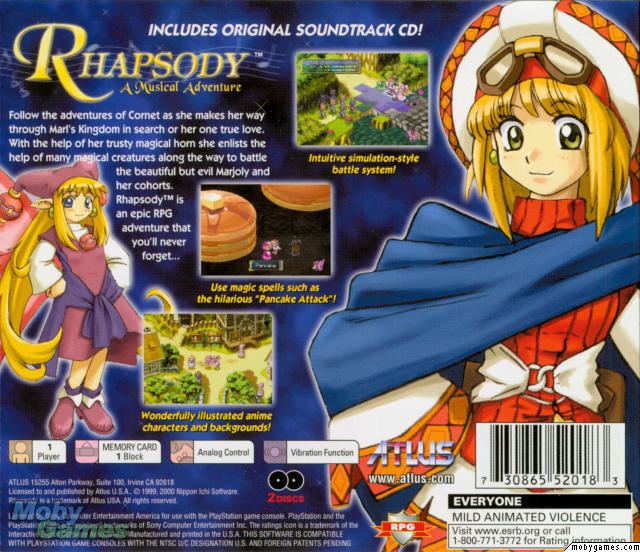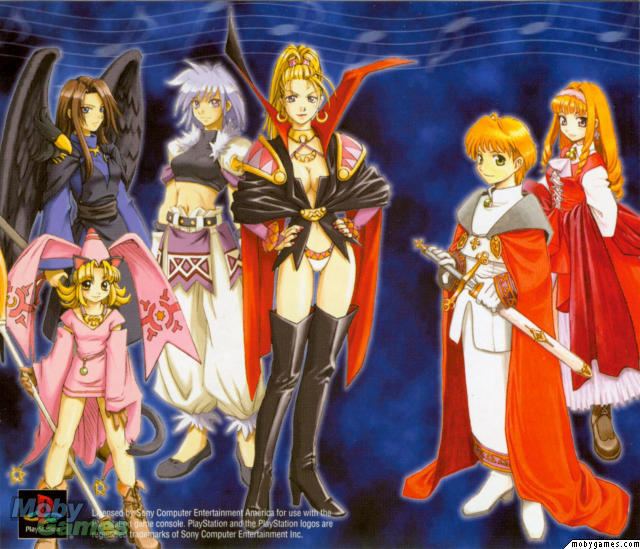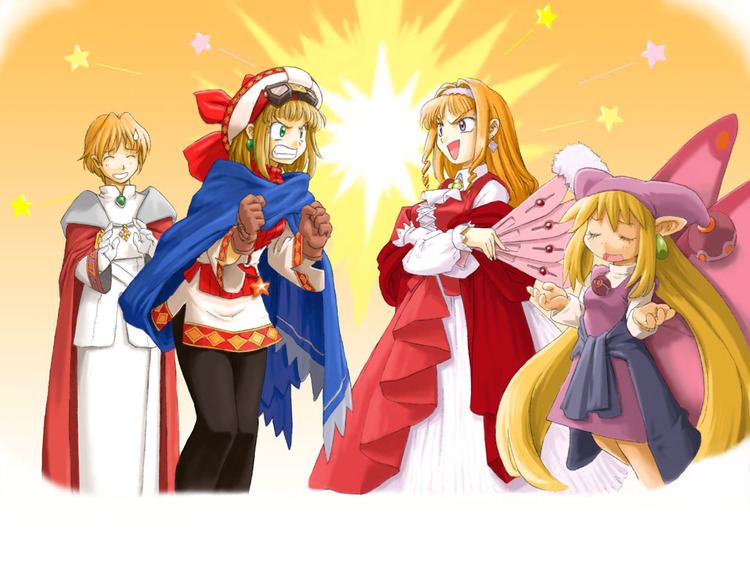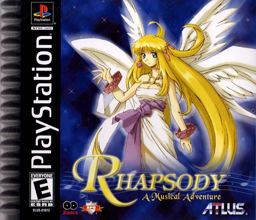7.8 /10 1 Votes7.8
7.3/10 IGN Director(s) Kōichi Kitazumi Initial release date 17 December 1998 | 4.6/5 Emuparadise 67% Metacritic Composer(s) Tenpei Satō Series Marl Kingdom | |||||||||||||||||||||||||||||||||
 | ||||||||||||||||||||||||||||||||||
Producer(s) Sōhei NiikawaKōichi Kitazumi Designer(s) Sōhei NiikawaRyōji Nomura Artist(s) Ryōji NomuraNoriaki KitamuraMasayuki Aikawa Writer(s) Sōhei NiikawaKōichi Kitazumi Similar Nippon Ichi Software games, Tactical role-playing games, Other games | ||||||||||||||||||||||||||||||||||
Rhapsody a musical adventure ds trailer
Rhapsody: A Musical Adventure, released in Japan as The Puppet Princess of Marl Kingdom (マール王国の人形姫, Māru-ōkoku no Ningyō-hime) is a tactical role-playing game for the PlayStation from Atlus USA and Nippon Ichi Software, the creators of Disgaea, and is part of the Marl Kingdom series.
Contents
- Rhapsody a musical adventure ds trailer
- Rhapsody a musical adventure retro let s play co optitude ep 40
- Gameplay
- Battles
- Story
- Characters
- Release
- Soundtrack
- Nintendo DS version
- Reception
- Legacy
- References

It was released four times in Japan — once in 1998, then again as The Adventure of Puppet Princess + 1 in 1999, and then again as The Adventure of Puppet Princess (PSone Books) in 2001, and then a fourth time for the Nintendo DS on August 7, 2008. The game was released in the United States, in 2000 and in 2008 and is the only game in the main series to be released outside Japan. A version of the game was also released on mobile phones.

Rhapsody, along with its sequels, are considered musical RPGs, meaning in place of FMV cutscenes, there are musical numbers, complete with vocals. The game is also known for its "overwhelming cuteness" and low level of difficulty. Although this may make the game seem geared towards a younger audience, in Japan, the game and series in general has seen much success.

Rhapsody a musical adventure retro let s play co optitude ep 40
Gameplay
When starting a new game, the player can select a game difficulty (easy, normal, or hard), which affects how long it will take to finish the game. The player selects different places on the world map and encounters random encounter battles, such as in the Dragon Quest series. Unlike most role-playing video games, the player can save at any time, except during battle.
An oft-mentioned point of appreciation is its relatively unique plot premise and flow. Rhapsody is a theatrical musical in regard to its presentation style, containing frequent cut scenes that are sung, rather than simply spoken and acted. Players are given the option of listening to the lyrics and voice-overs in Japanese, English, or muting them entirely. Hidden throughout the game are high-quality illustrations of characters, which can be viewed any time through the item menu.
Battles
The battles are fought in a tactical role-playing game fashion. However, unlike other games in this genre, the battles tend to last less than a minute, with the exception of boss battles, and require little tactics. This makes the game stand out in its genre and may have also led to its limited mainstream success with more hardcore players of the genre.
Cornet is the main character, but mainly offers support in battle-puppets that are found throughout the game do most of the fighting for her. Kururu never actually fights in any battles in the original, though she does in the remake for the DS. Each character learns different skills as they level up, except Cornet (in the original only), who has attacks called Rewards. Cornet can blow her horn during battle to power up the puppets and gain appreciation points, which allow her to unleash these devastating techniques. Most Rewards are represented by foods, such as flan, cake, and candy.
Like in most tactical RPGs, each character has a certain move number and can attack at a certain distance. Most party members can only attack at close range, unless he or she has a long-range skill. Each character can also equip three accessories and use items. The game features some normal status problems (sleep, paralysis, etc.) like in most console RPGs, but has some original ones too, such as frog and philanthropy. Each enemy also has an element (thunder, wind, earth, fire, water, dark, holy) and a weakness to the opposite element. Each element has its own set of spells, which can be used to take advantage of such weaknesses.
Unlike in most tactical RPGs, instead of gaining experience points each turn, all the characters get the same amount of points at the end of battle. After earning enough experience points, the character will level up and become stronger and possibly learn a spell. There are also skill points, gained when a character strikes the finishing blow. The more of these points a character has, the higher his or her critical rate becomes. Inotium, the in-game money, is also won after every battle. Occasionally monsters will join Cornet after they are defeated. These monsters can then be used in battle, like puppets, and can use special monster abilities.
Story
The game centers around the adventures of Cornet, a girl who can talk to puppets and has a magical horn that grants wishes, and Kururu, a puppet that has the heart and soul of a human. The majority of the game is about Cornet and Kururu trying to save Prince Ferdinand (whom Cornet is in love with) after he has been turned to stone by the self-proclaimed "most beautiful witch in the world." The witch, Marjoly, also has a crush on the prince and had meant to put him to sleep, but messed up the spell and accidentally turned him to stone.
Characters
Release
After the first release of the game, a cheaper edition called The Adventure of Puppet Princess + 1 was published, which featured an art gallery, sound test, and a bonus CD. The North American release of the game had these features, but instead of the bonus CD was a soundtrack CD, with vocal and instrumental songs from the game. The third release (The Adventure of Puppet Princess (PSone Books)), did not come with any extra CD. There was also a Rhapsody calendar released.
Soundtrack
Bundled with the North American version of the game was an original soundtrack CD (Rhapsody - A Musical Adventure USA Soundtrack). All songs were composed by Tenpei Sato.
Nintendo DS version
Rhapsody: A Musical Adventure was released for the Nintendo DS on September 23, 2008. The gameplay has been changed significantly, the battles changed from strategy-RPG style to 2-D turn-based battles, similar to the ones found in the sequels. Kururu also engages in battle in this version of the game. Though extra scenarios from the third game in the series were advertised, translated, and given as the reason for the removal of the English song vocals, they were absent from the game. NIS America announced that they removed this content because of localization issues. Reports of glitches have also surfaced such as freezing.
Reception
The DS version received "average" reviews according to the review aggregation website Metacritic.
Legacy
Rhapsody: A Musical Adventure has a sequel, Little Princess: Marl Ōkoku no Ningyō Hime 2, which has been fan-translated. The third game, Tenshi no Present: Marl Ōkoku Monogatari, also known as Angel's Present: A Marl Kingdom Story, has also been translated by fans.
Rhapsody's influence has extended into Nippon Ichi's subsequent series of tactical role-playing games. One of the characters of La Pucelle: Tactics is a descendant of the characters in the game, while the shops named after Cornet's rival, Etoile Rosenqueen, have spread even to the Netherworlds of Disgaea: Hour of Darkness. Antiphona no Seikahime: Tenshi no Gakufu Op.A takes place in the same world and features Marjoly, who also appears in Disgaea 3: Absence of Justice as DLC (and like all other DLC, is included with the Vita port, Absence of Detention, for free) and makes cameo appearances in each game of the Disgaea series.
